10 Zapier Alternatives to Automate Your Workflows in 2025

Ever hit Zapier’s task limit right when you needed it most? Or watched costs spike as your team tried to scale?
Many users run into the same problem: Zapier is for quick setups but less reliable when you need to deal with complex workflows, automate complex business processes, or add custom functions. That’s why more teams are switching to Zapier alternatives.
In this guide, we’ll look at the top alternatives to Zapier for better automation.
Try Activepieces for free today and see how easy automation can be!
Why Consider an Alternative to Zapier in 2025?
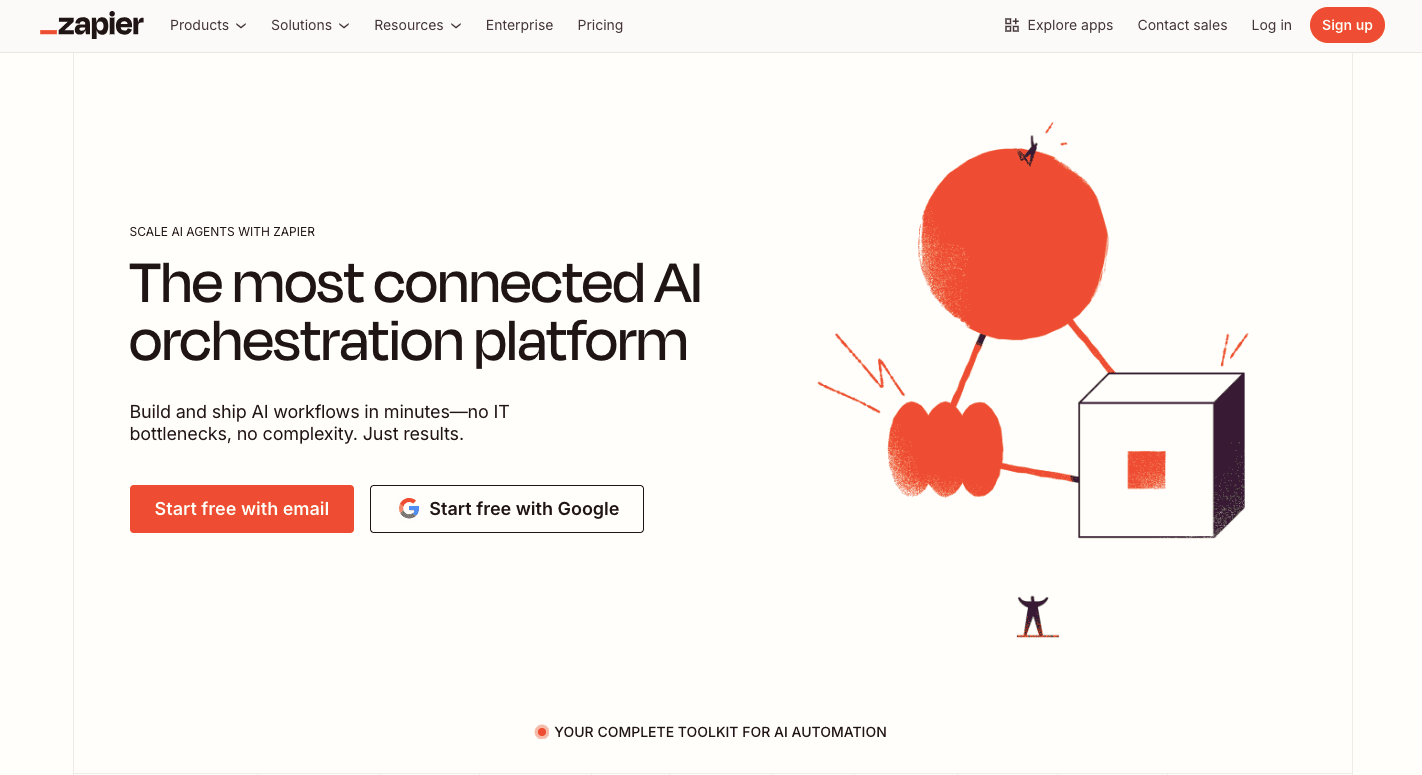
Zapier automates routine tasks, like sending emails or creating CRM records after form submissions. Its “trigger-action” model makes it easy to automate tasks without code and aids in simplifying workflow creation.
Still, many users report a steep learning curve once workflows grow more complicated. When you try to build branching flows, loops, or triggers with conditions, you run into a complex setup that slows down automation projects.
It gets worse for teams wanting to automate complex business processes together. Since there are insufficient features for real-time teamwork, you’ll find it harder to share or collaborate when you need automation solutions across multiple people.
Regarding pricing, Zapier offers a free plan with a hundred tasks per month and basic features with delays in checks (every 15 minutes). The Professional plan costs $29.99, while the Team plan costs $103.50 per month.
Even though Zapier supports custom functions and templates, it still struggles with high-volume or deeply conditional workflows. For those reasons, many turn to Zapier alternatives.
10 Best Zapier Alternatives to Upgrade Your Marketing Automations
Today, plenty of workflow automation tools give marketing teams more control, lower costs, and features that fit modern campaigns better, such as:
1. Activepieces
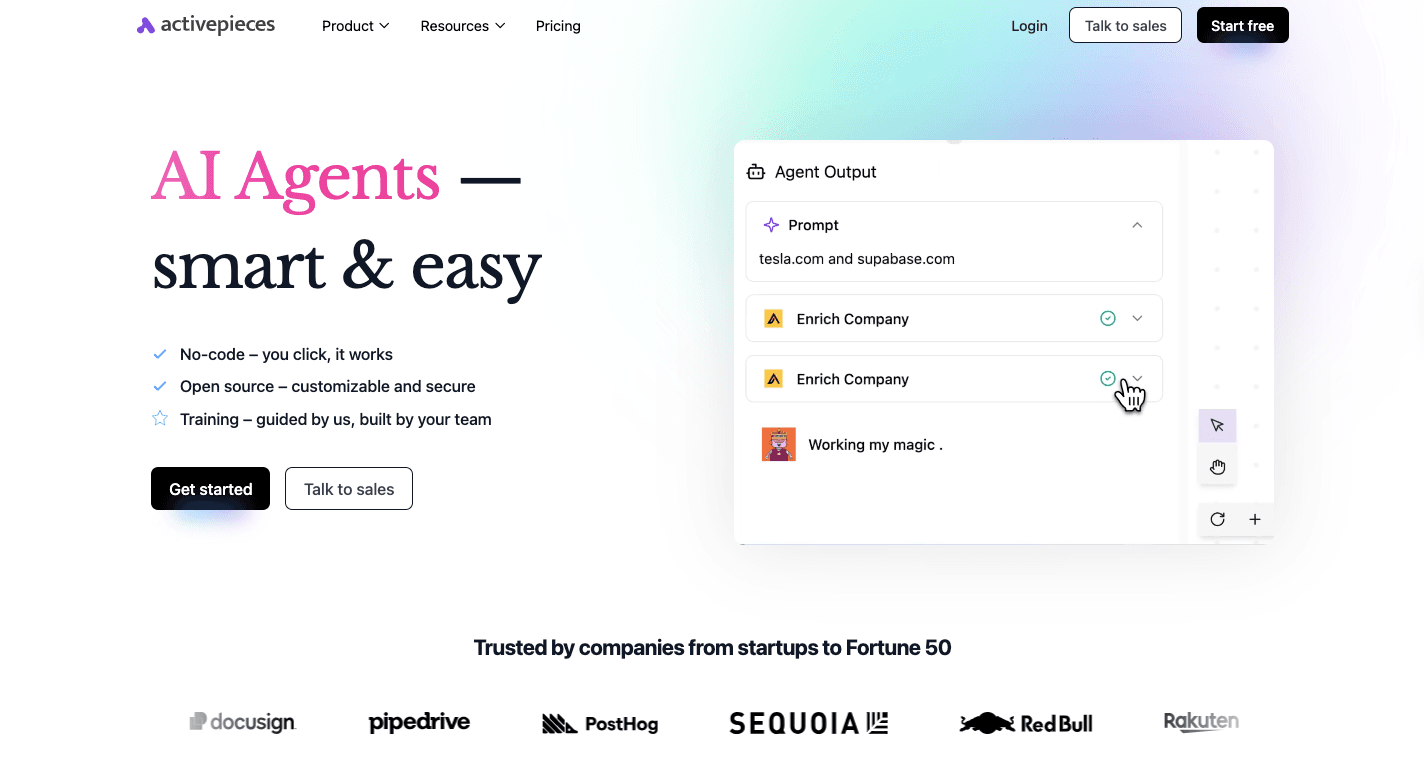
Activepieces makes automation feel effortless while giving you enterprise-level power. It combines a drag-and-drop interface for non-technical users with a TypeScript framework for developers who want more control.
You don’t have to worry about paying extra for every single task. Aside from offering a free plan, you get flat-rate pricing.
Currently, the library of “pieces” (integrations) is already at 416 and growing daily because the community keeps adding new ones. That’s a huge edge compared to the alternatives that lock you into slow, closed ecosystems.
From AI providers and CRMs to finance apps and collaboration platforms, Activepieces connects them in a single place. You can even host it yourself for unlimited automations and complete control over sensitive data.
Features
Activepieces delivers features to help your teams move faster:
- Drag and drop interface – Build flows quickly without needing code.
- Extensive integration capabilities – 416 pre-built “pieces” cover AI, CRM, productivity, finance, and more.
- Open ecosystem – Pieces are written in TypeScript, allowing custom development and hot reloading.
- AI-ready – Native AI integrations and an SDK to build custom AI agents.
- Human-in-the-loop – Add approval steps, delays, or manual inputs inside automations.
- Advanced data manipulation – Transform, format, and enrich data between steps.
- Enterprise-level automation features – SSO, branding controls, secret management, and scalable deployments.
Integrations
Activepieces has the fastest-growing integration libraries in the automation space. Right now, there are 416 pieces, but that number changes daily as the community adds more.
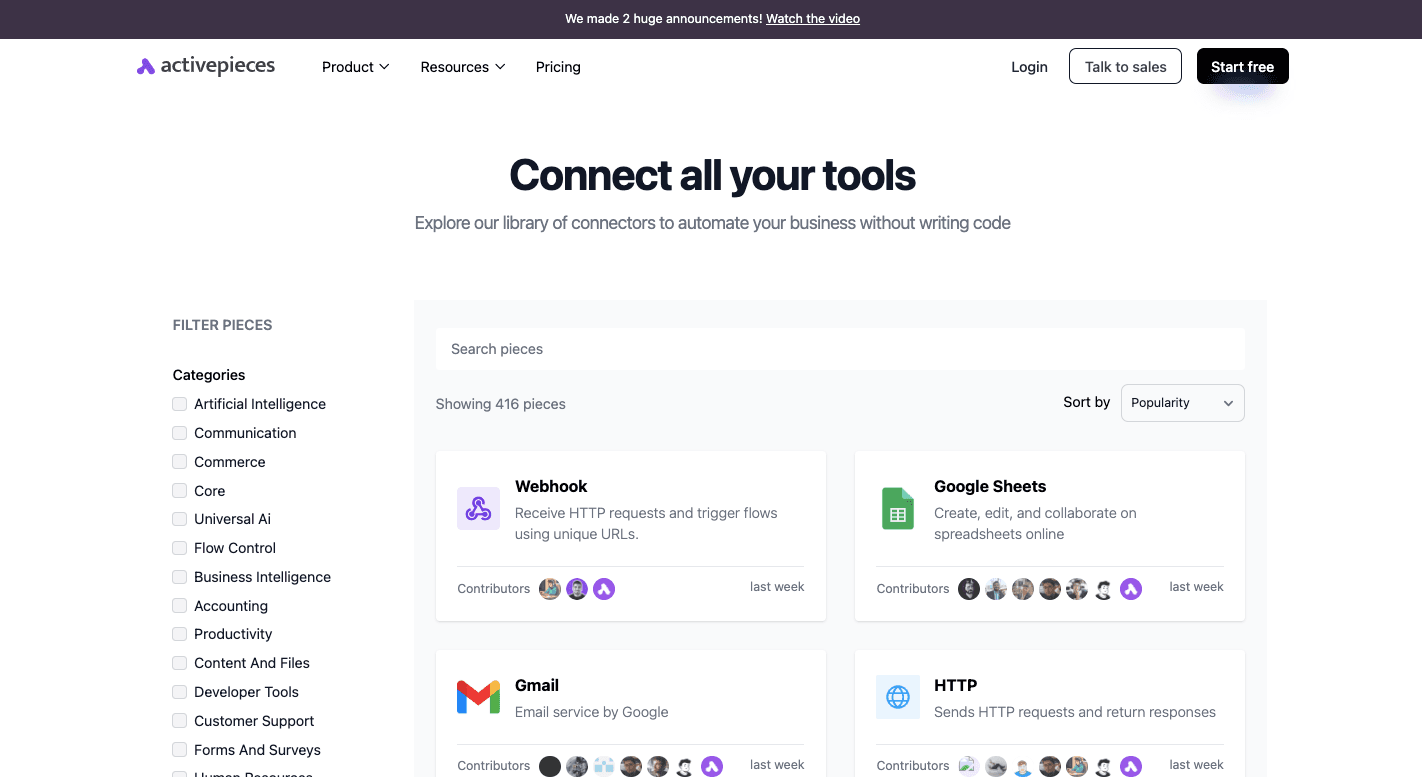
You can connect your favorite AI platforms like OpenAI and Google AI Studio, productivity tools like Google Sheets and Slack, CRMs like Zoho and Microsoft Dynamics, and finance tools like Zoho Books.
Pre-built connectors integrate seamlessly, but developers can also create new pieces with TypeScript and share them with the community. That means Activepieces evolves at a pace that closed platforms can’t match.
While other alternatives struggle to keep up, Activepieces keeps expanding its ecosystem to cover every corner of your business stack.
Use Cases
Activepieces adapts to basically any workflow for growing businesses and enterprises alike. You can:
- Capture leads, update your CRM, and send instant notifications to Slack.
- Schedule posts, track performance in Google Sheets, and trigger AI-powered summaries.
- Route tickets from Zoho Desk into collaboration channels for faster responses.
- Automate onboarding by syncing employee data across communication and payroll systems.
- Build agents that write reports, summarize customer chats, or generate campaign drafts automatically.
A lot more opportunities are unlocked because the library of pieces expands every day.
Pricing
Activepieces offers a Community Edition that’s completely free, open-source, and self-hosted, with no task limits. The cloud version starts with a free plan offering 1,000 tasks and two flows.
The Plus plan at $25 per month includes unlimited tasks, AI agents, and email support. On the other hand, the Business Plan at $150 per month adds 50 flows, API access, and multiple users. Enterprises can get custom pricing with dedicated support and advanced controls.
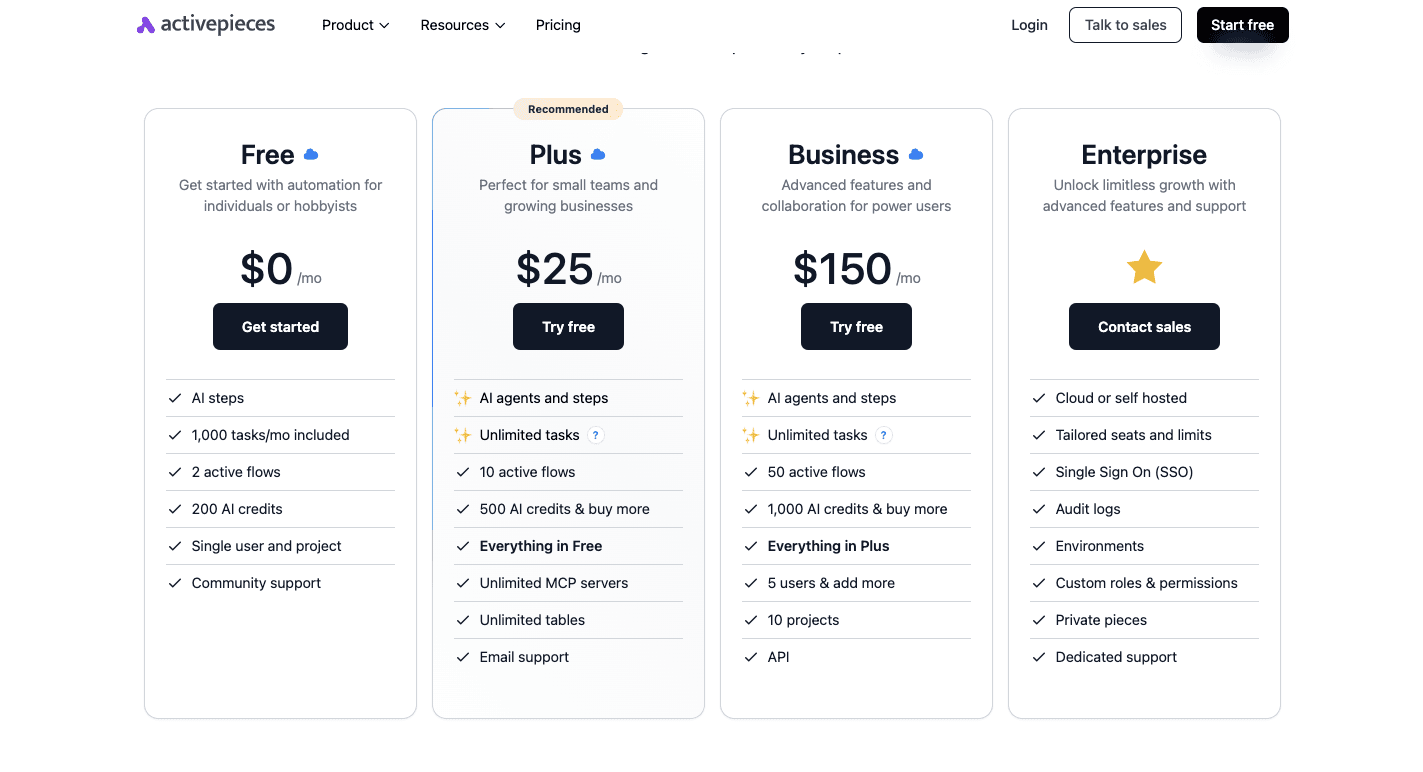
Compared to Zapier’s expensive per-task pricing and Make’s unpredictable operations model, Activepieces saves you money while still automating without limits.
Speak with our sales experts to find the right Activepieces plan for your business!
2. Microsoft Power Automate
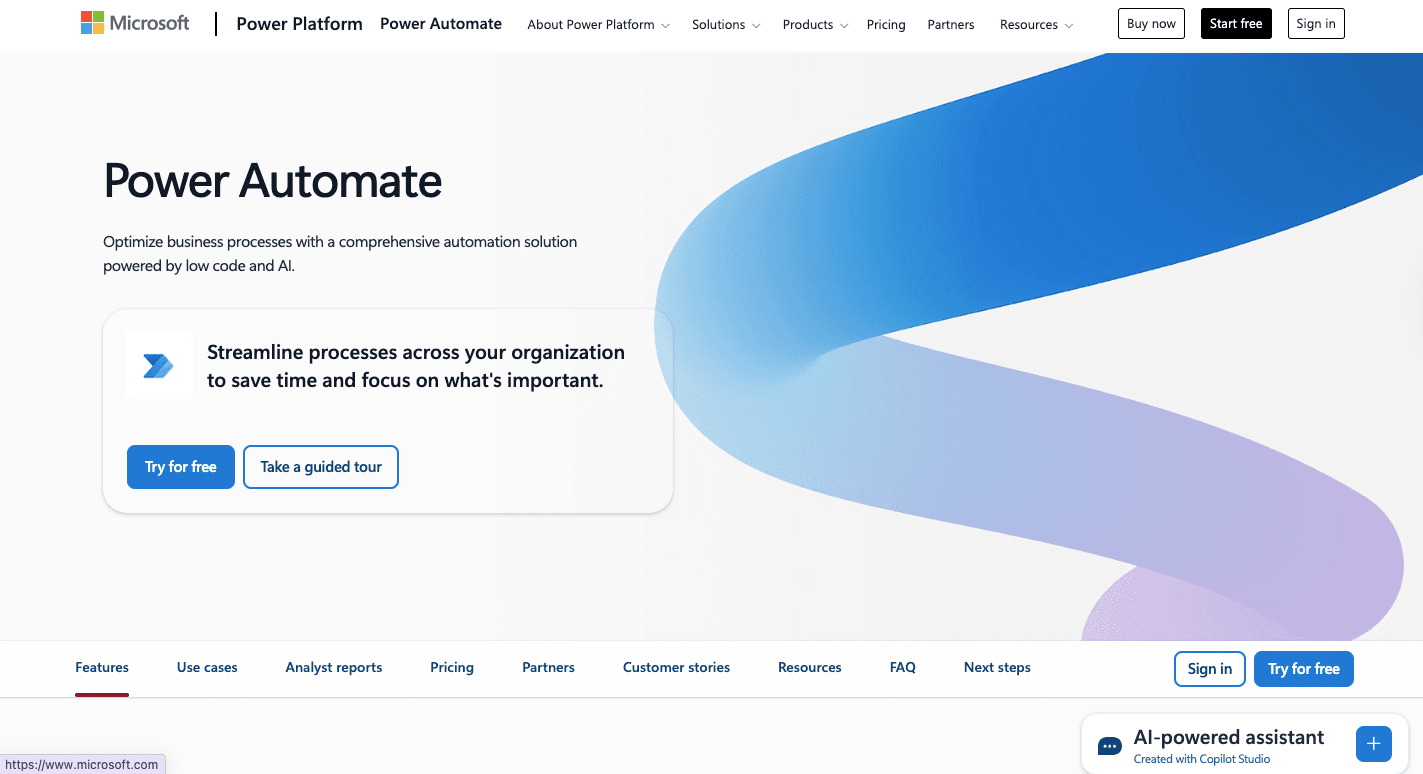
Microsoft Power Automate is an automation platform within the Microsoft Power Platform that connects Office tools with third-party services. Companies use it to manage workflows across Outlook, Teams, SharePoint, and outside cloud apps like Salesforce or Dropbox.
Many organizations adopt it to cut down on repetitive tasks such as approvals, notifications, and data entry. For teams with basic automation needs, it offers ready-made templates and simple flows. As demands grow, Power Automate extends into robotic process automation and AI-driven processes.
The user interface combines a low-code builder with drag-and-drop elements. Alongside advanced features like AI Builder, desktop flows, and predictive insights, it’s more convenient for businesses already invested in Microsoft’s ecosystem.
Features
Power Automate includes a range of options for small teams and enterprises:
- Cloud flows – Automations triggered by events, schedules, or button clicks.
- Desktop flows – RPA that records actions for desktop and legacy systems.
- Business process flows – Step-by-step guidance for structured processes.
- Work queues – Tools to prioritize and distribute automation tasks.
- AI builder – Advanced features for predictions, document reading, and AI-assisted automation.
- Templates – Pre-built flows for simplifying workflow creation.
- Connectors – Over a thousand integrations with Microsoft and third-party cloud apps.
Pros
- Integrates deeply with Microsoft 365.
- Template library speeds up simple builds for basic automation needs.
- The user interface is approachable for non-technical staff.
Cons
- Complex flows may slow down or fail.
- Troubleshooting relies on vague error logs.
- The user interface feels cluttered in bigger builds.
Pricing
Microsoft 365 subscriptions include a light version of Power Automate for workflow automation, though it has strict limits. Premium licenses start at $15 per user each month, adding unlimited flows, premium connectors, and attended robotic automation.
The Process plan costs $150 per bot monthly and supports unattended RPA and shared flows across teams. On the other hand, the Hosted Process plan is $215 per bot each month and includes a managed virtual machine.
3. Huginn
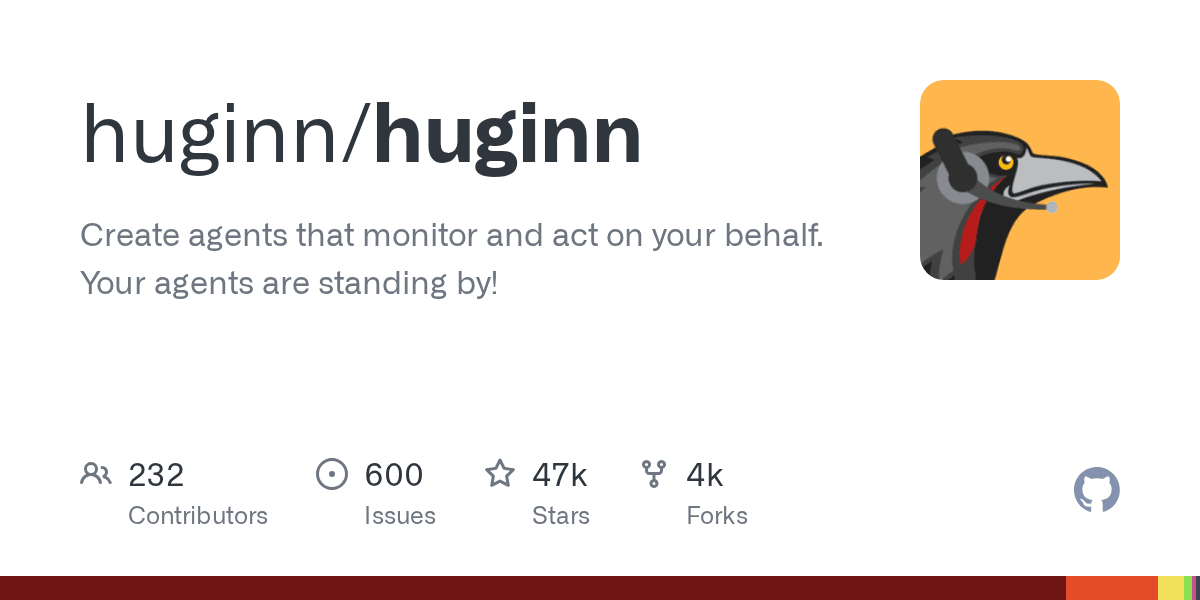
Huginn is an open-source automation platform that runs on your own server.
The system is constructed around modular “agents” that collect data, react to triggers, and send outputs to other agents. Rather than relying on a hosted service, Huginn allows you to define exactly how data flows and where it is stored.
You can also create workflows that combine multiple agents into complex scenarios. These workflows can respond to changes in both online services and internal systems.
As an open-source project, it also benefits from a community of developers adding new options and integrations. In practice, it functions as an open-source system for building agents that automate tasks by monitoring events, scraping data, and taking predefined actions.
The trade-off, however, is that it requires more technical knowledge than commercial alternatives.
Features
Huginn provides a wide set of features for automation:
- Agents – Modular components that perform tasks like scraping sites, sending emails, or monitoring feeds.
- Events – JSON-based data packages that pass between agents to trigger the next action.
- Scenarios – Chains of agents connected to create workflows for larger goals.
- Web scraping and data handling – Extract, filter, and transform information from websites or APIs.
- Custom agents – Developers can build unique functions to connect with any API.
- Notification triggers – Alerts via email, SMS, or webhooks when conditions are met.
- Self-hosting – Full ownership of data and operations since it runs on your own server.
- Open-source – No license fees and an active community contributing add-ons.
- Support for services – Operates with RSS feeds, Twitter, Slack, and various APIs.
Pros
- Full data privacy since it’s self-hosted.
- Highly customizable with custom functions and agents.
- Not tied to vendor pricing or policy changes.
Cons
- Requires ongoing server setup and maintenance.
- The web interface is less polished and intuitive.
- Fewer native integrations available by default.
Pricing
Huginn is completely free to download and use since it’s an open-source project. You won’t pay subscription fees or licensing costs. The only expense is running infrastructure such as a VPS or dedicated server.
4. Pabbly Connect
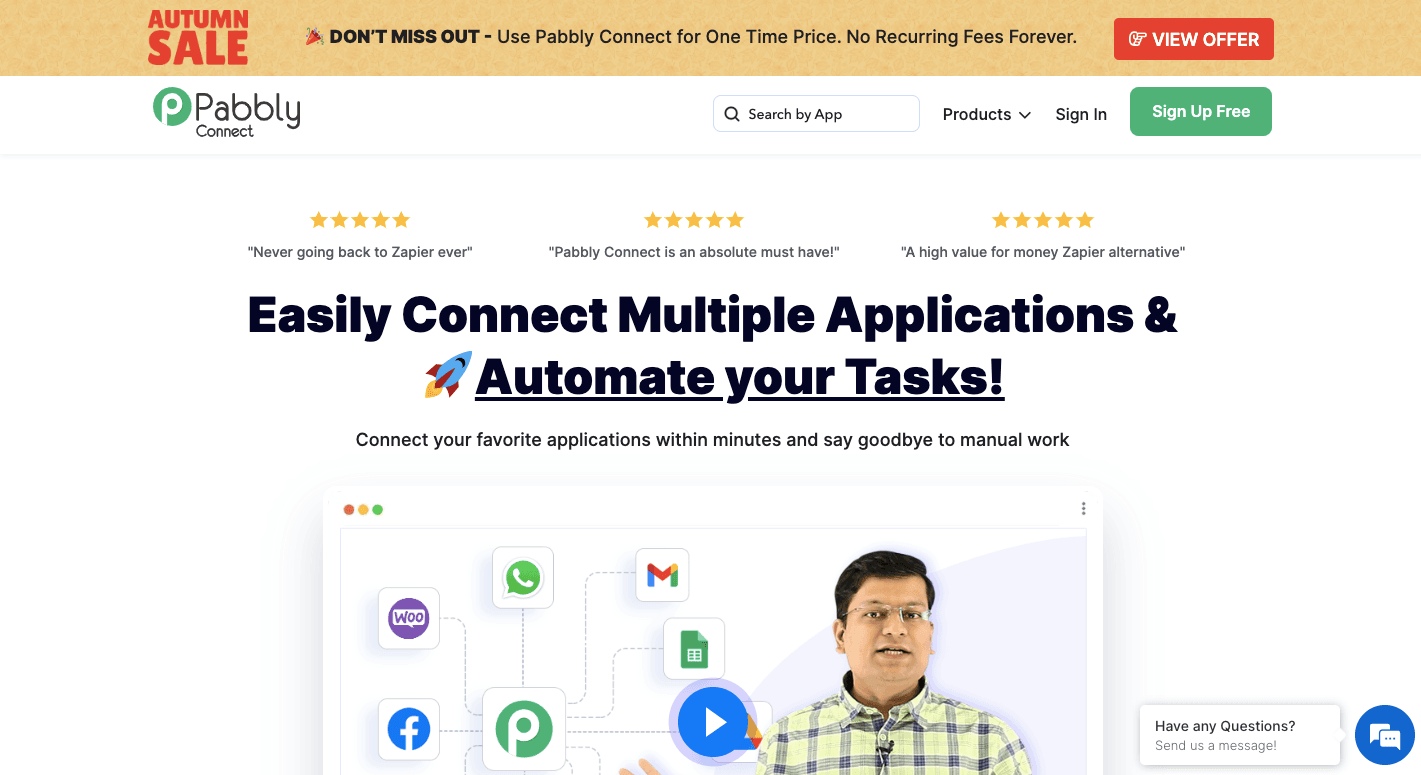
Pabbly Connect is an automation platform that runs on triggers and actions.
Many pick it over Zapier since it includes free internal tasks, offers lifetime deals, and has a free plan that provides unlimited workflows. For teams with basic automation needs, it provides an entry point, while larger companies do advanced workflows with multi-step actions.
Although Pabbly claims to have a user-friendly interface, some user reviews suggest it has a learning curve that’s steeper than Zapier. Still, it’s a better alternative to cost-conscious users who need an inexpensive way to build custom workflows.
Features
Main features inside Pabbly Connect include:
- Triggers and actions – Simple setup to connect apps and move data.
- Multi-step flows – Build advanced workflows with multiple actions after a single trigger.
- Filters and routers – Add logic and branching for more control.
- Schedulers and delays – Time workflows for exact needs.
- Formatters – Reformat text, numbers, or dates in real time.
- Email parser – Extract key data from incoming messages.
- Webhooks – Connect with services lacking direct integrations.
- Internal tasks – Free processing steps like filters and formatters.
- Custom variables – Personalize data handling inside workflows.
Pros
- Lifetime deals are available to avoid recurring costs.
- Internal tasks don’t count toward limits.
- Supports advanced workflows with routers and schedulers.
Cons
- Reports of a steeper learning curve despite claims of a user-friendly interface.
- Customer support is slower on lower plans.
- Limited AI capabilities compared with other tools.
Pricing
Pabbly Connect offers multiple tiers, including a free plan with a hundred tasks per month and unlimited operations, unlimited workflows, and free internal tasks.
Paid plans depend on task count: $16 per month for 10,000 tasks, $39 per month for 20,000 tasks, and $79 per month for unlimited automation. These include premium apps, shared folders, enhanced security, and over 2,000 integrations.
5. Apache NiFi
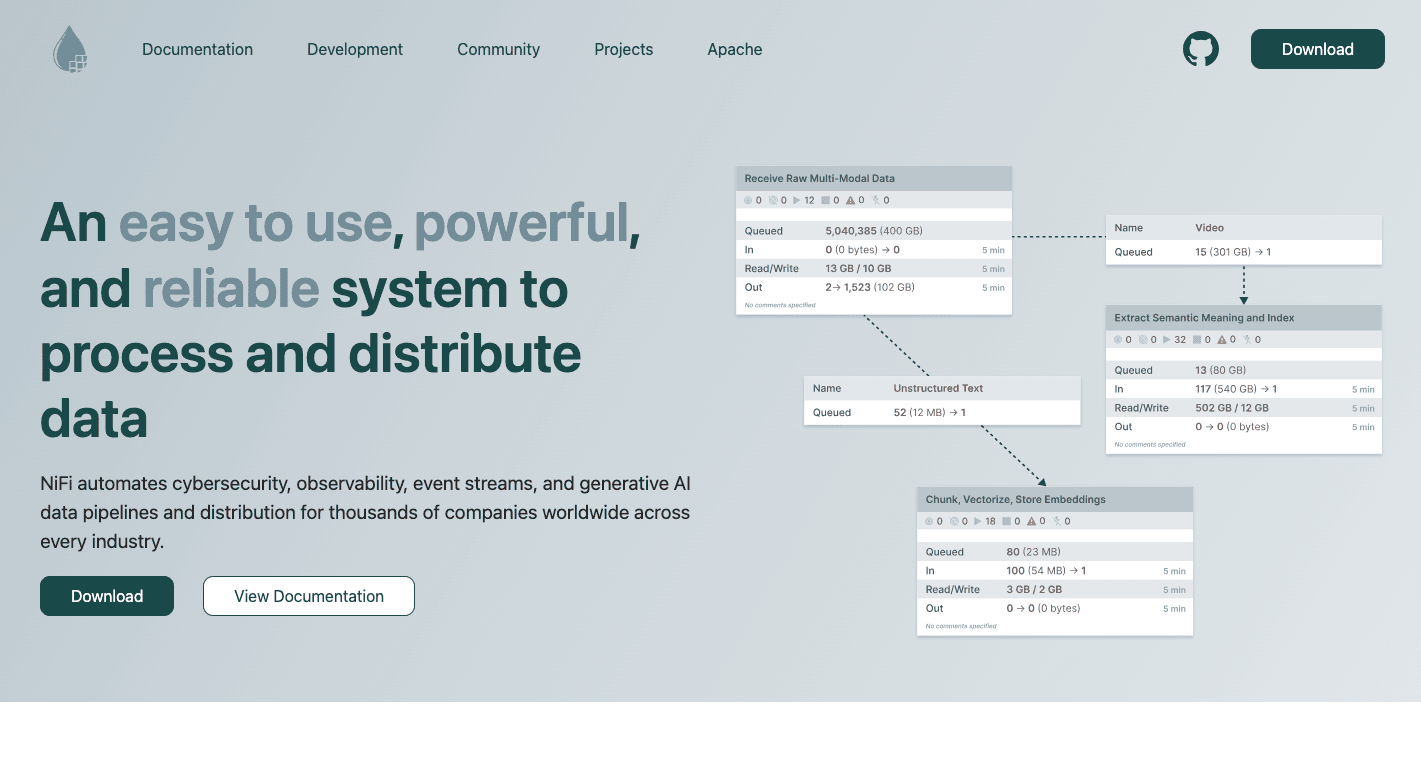
Apache NiFi is an open-source platform that manages data flows between systems with precision and flexibility. Originally developed by the NSA, it’s currently maintained by the Apache Software Foundation.
Organizations adopt NiFi to handle complex automation tasks like routing, filtering, and transforming data. Besides that, the web-based canvas provides a drag-and-drop design that simplifies building automation processes, but it also supports advanced configurations for technical teams.
NiFi further excels at moving data across systems, even under heavy loads. It gives you confidence that sensitive data remains secure while flowing through pipelines.
Beyond visual design, NiFi allows you to write custom processors to extend functionality and create integrations unique to their systems. And those who need to manage complex tasks across many apps and protocols often turn to NiFi because it delivers enterprise-grade data flow management.
Features
NiFi includes a wide range of features for data movement and security:
- Flow management – Build, control, and monitor flows with guaranteed delivery.
- Back pressure and buffering – Queues prevent overload while prioritizing urgent data.
- Processor library – Hundreds of built-in processors for ingestion, routing, and transformation.
- Flow templates – Reusable patterns for rapid deployment.
- Expression language – Fine-tune flow behavior with dynamic rules.
- Security controls – Encryption, authentication, and multi-tenant authorization.
- Data provenance – Full lineage tracking with replay options for auditing.
- Custom extensions – Developers can add processors or services to meet unique needs.
Pros
- Drag-and-drop UI helps users design data flows visually.
- Reliable delivery through queues and repositories.
- Built-in encryption to protect sensitive data.
Cons
- Requires technical knowledge for advanced tuning.
- Limited for heavy transformations compared with Spark or Hadoop.
- Offers fewer native integrations than some commercial tools.
Pricing
Apache NiFi is free as an open-source project under the Apache Software Foundation. There are no licensing fees or subscription costs.
The only expenses come from the infrastructure required to deploy it, such as on-premises or in the cloud, along with the staff needed to configure and maintain production environments.
6. Appy Pie Automate
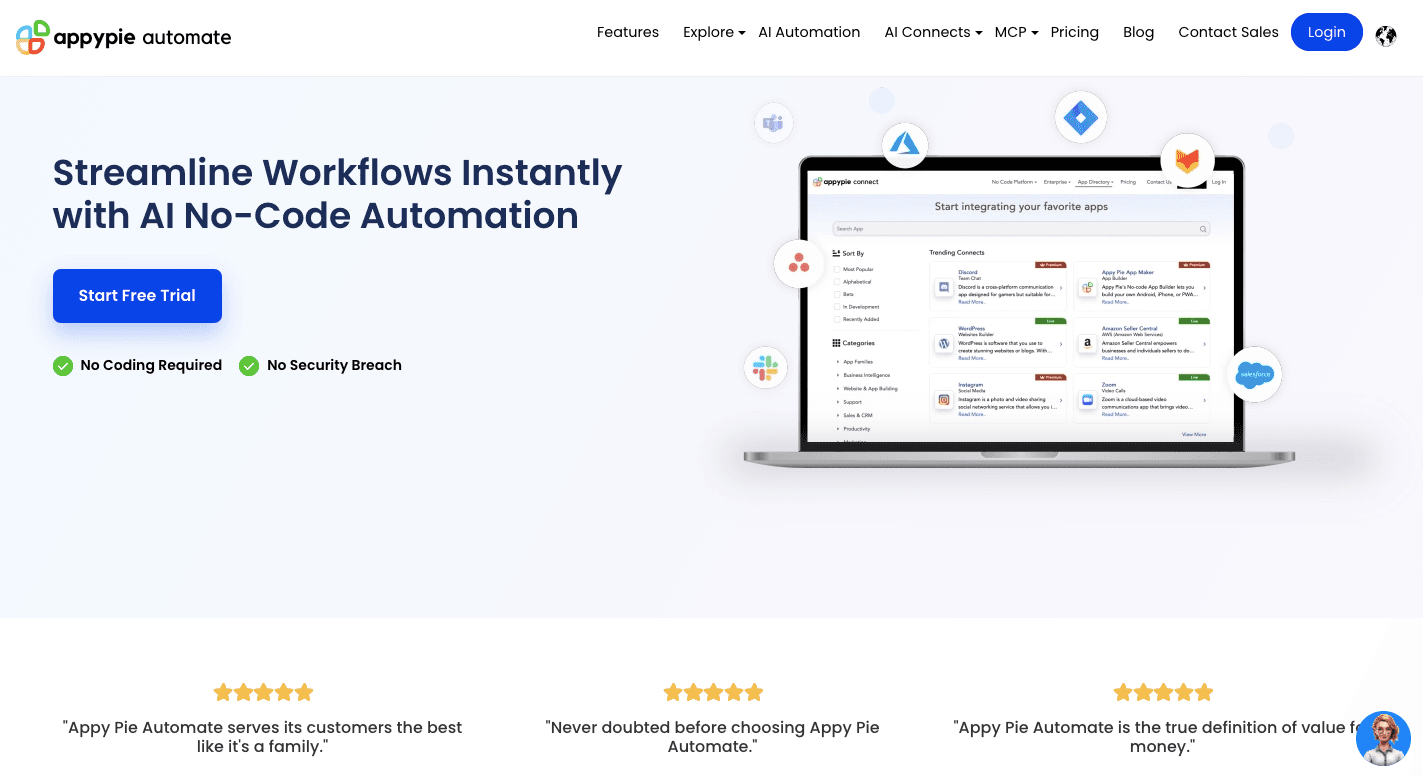
Appy Pie Automate offers a beginner-friendly visual automation platform for small businesses and solo users. It makes task automation easy for users who want to save time on repetitive work since it runs on triggers and actions.
The system enables users to connect over a thousand apps with a plain-language builder as well. You type what you want, and the AI suggests a draft automation you can adjust. Then the drag-and-drop canvas gives you an intuitive interface to refine those automations.
Pre-built templates even cover common cases like lead capture or email follow-ups. Appy Pie also includes basic error handling, so when a task fails, the system retries or alerts you without disrupting the flow.
Features
Key functions include:
- AI workflow builder – Generate workflows from simple prompts.
- Triggers and actions – Fire tasks when specific events occur.
- Multi-step flows – Run several steps in sequence.
- Conditional logic – Add “if-then” rules for adaptable responses.
- Data formatters – Clean and adjust text, numbers, and dates.
- Webhooks – Extend automations with custom connections.
- Pre-built templates – Launch workflows instantly.
- Integrations – Connect CRM, marketing, and e-commerce apps.
- Agentic automation – AI agents adapt workflows in real time.
Pros
- Delivers an intuitive interface for non-technical users.
- Connects with over a thousand apps across categories.
- Templates make setup quick and simple.
Cons
- Locks advanced tools like conditional paths behind higher plans.
- Falls short for highly customized or complex tasks.
- Some training content looks outdated.
Pricing
Appy Pie Automate provides a 7-day free trial with limited features. The Standard plan costs $12 per month and covers 15,000 tasks and 40 AI agents. Then the Professional plan costs $30 per month with 50,000 tasks, unlimited agents, and faster run times.
Meanwhile, the Business plan costs $80 per month and supports 150,000 tasks, advanced integrations, and team access. Enterprises get custom pricing with compliance features, account management, and priority support.
7. Workato
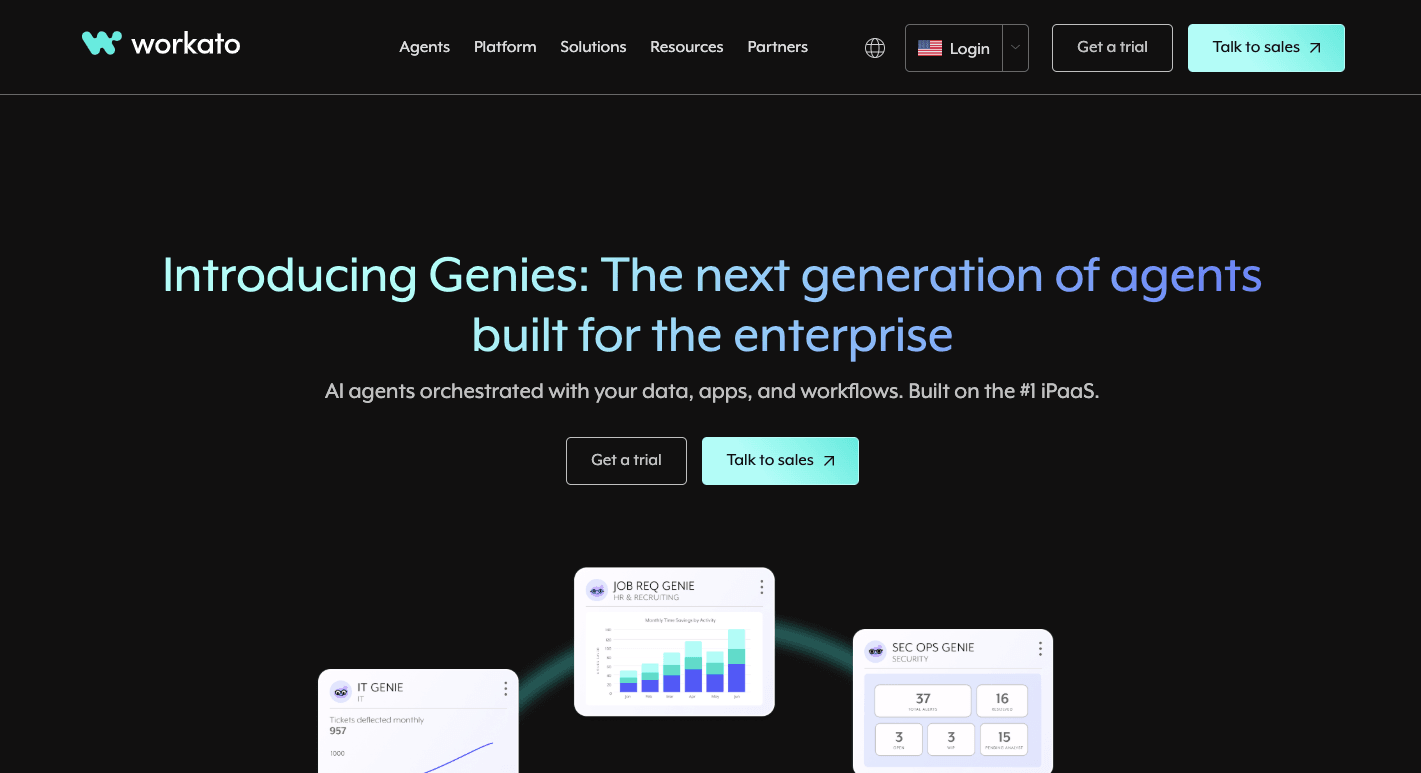
Workato is an enterprise-focused automation platform that connects cloud and on-premise applications while keeping security and compliance in place. Many enterprises choose Workato because it combines a low-code interface with advanced developer tools.
The automated workflows, called “recipes,” are triggered by events in connected apps. You can use these recipes to build in formulas, transformations, and custom logic for advanced scenarios.
You also get integration support for thousands of services, including ERP systems, CRMs, and popular app integrations like Salesforce or Slack. Even better, your team can build their own workflows with detailed control and governance.
The platform also includes support for conditional logic through its “if control statement,” which allows flows to branch based on rules.
Features
Key functions available in Workato include:
- Recipes – Automated workflows built with triggers and actions.
- Low-code interface – Drag-and-drop builder for business users, plus code options for developers.
- Connectors – Over a thousand pre-built connectors for popular app integration, plus custom SDK connectors.
- Data transformation – Tools for cleaning, formatting, and mapping data.
- Real-time sync – Keep data updated instantly across connected apps.
- Community recipes – Library of 225,000+ ready-to-use automations.
- AI features – RecipeIQ and Workato Genie assist with recipe building and optimization.
- API management – Create, publish, and govern APIs tied to automation.
- Error handling – Retry failed actions and configure fallback workflows.
- Workbot – Trigger recipes and manage tasks from Slack or Teams.
Pros
- Broad integration support across cloud and on-premise apps.
- Real-time sync and conditional logic make flows dynamic.
- Trusted by enterprises needing strict compliance.
Cons
- High pricing, with custom quotes for every deal.
- Steeper learning curve for advanced features.
- Debugging recipes can be frustrating with limited error detail.
Pricing
Workato doesn’t publish standard pricing.
8. MuleSoft
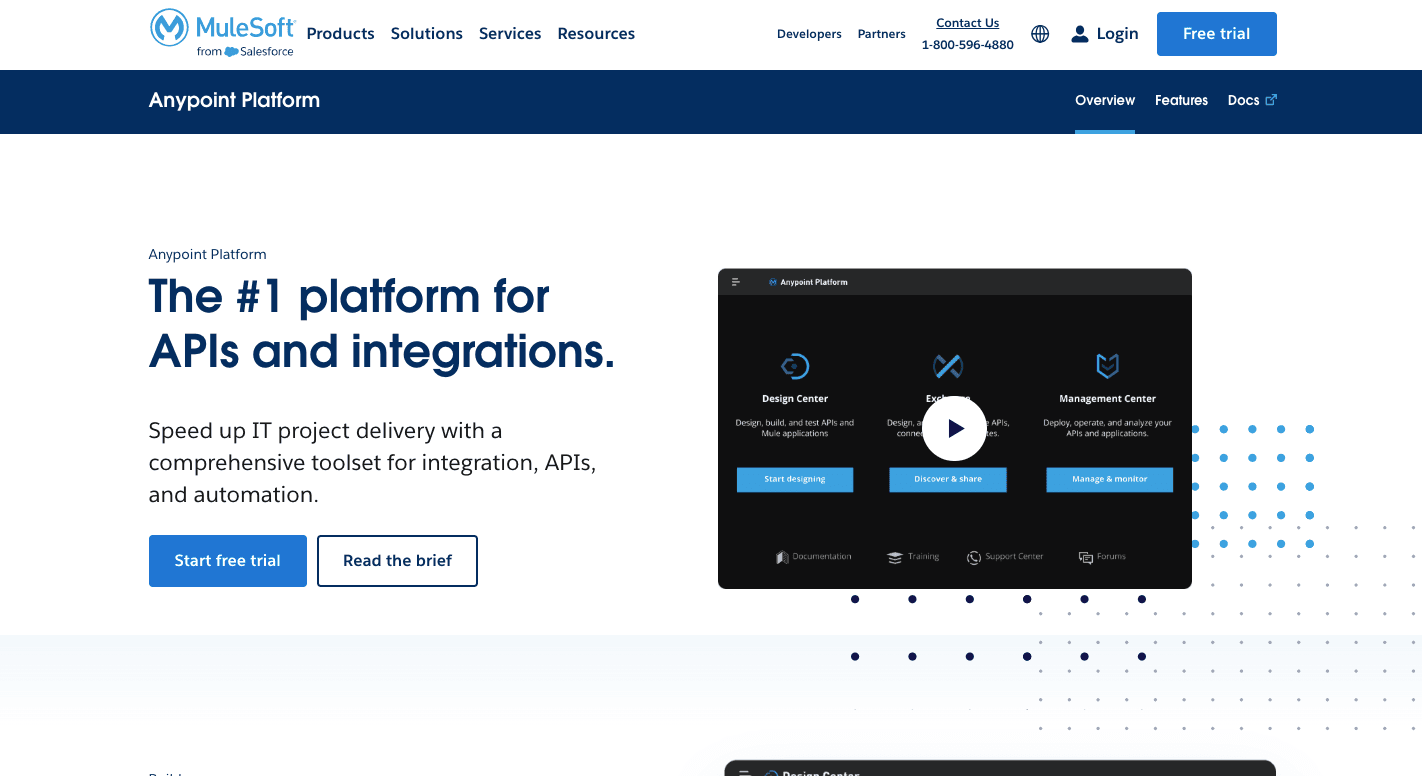
MuleSoft is an enterprise-grade integration platform that connects apps, data, and services across on-premises and cloud environments. Salesforce acquired MuleSoft in 2018, and today its product, the Anypoint Platform, drives digital transformation efforts in large enterprises.
The platform structures integrations through an API-led approach with three layers: “System APIs” connect to core records, “Process APIs” combine and transform data, and “Experience APIs” deliver it to end-user apps. This approach builds reusable assets that cut future development time.
Anypoint Exchange then hosts pre-built connectors that integrate seamlessly with Salesforce and other enterprise tools. At the same time, the Anypoint Design Center provides a drag-and-drop visual interface for designing integrations.
Despite that, MuleSoft often faces challenges when integrating multiple systems across complex environments, which can require deep expertise and significant investment.
Features
MuleSoft gives you the following features:
- API-led connectivity – Build integrations through reusable Experience, Process, and System APIs.
- Anypoint design center – Use a visual interface to design and document APIs.
- Anypoint Exchange – Access pre-built connectors, templates, and reusable APIs.
- Mule runtime engine – Execute integrations with low latency across hybrid setups.
- DataWeave – Transform and map data across formats and sources.
- Anypoint management center – Secure, monitor, and analyze integrations in one place.
- Hybrid deployment – Deploy on cloud, on-premises, or containerized environments.
- Automated security – Apply policies for compliance with GDPR, PCI DSS, and ISO standards.
- Monitoring and analytics – Track API performance in real time.
Pros
- Wide library of connectors that integrate seamlessly with Salesforce and other enterprise platforms.
- Reusable APIs reduce development time and cost.
- Real-time monitoring supports quick issue resolution.
Cons
- Resource-heavy implementations need large IT teams.
- Some performance issues during heavy data loads.
- Salesforce bias may raise concerns about vendor lock-in.
Pricing
MuleSoft runs on an annual subscription model, but exact prices aren’t public.
9. Lindy

Lindy is a no-code platform that creates AI-powered agents, called “Lindies,” to handle repetitive work.
Unlike traditional marketing automation tools that follow strict rules, Lindy agents understand context, make decisions, and carry out multi-step actions across connected apps. The platform automates sales, customer service, scheduling, and inbox management with ease.
You can also describe what you want in plain English, and the system instantly drafts an agent workflow. For those who prefer more control, Lindy includes a visual workflow builder to design processes step by step.
There are even thousands of apps you can connect with, such as Google Workspace, Slack, Salesforce, and HubSpot. As conditions change, the agents adapt in real-time.
Features
Main features that Lindy offers:
- No-code agent builder – Describe workflows in plain English and generate agents.
- Pre-built templates – Use ready-made agents for tasks like meeting notes or lead generation.
- Triggers and actions – Run workflows based on events or conditions.
- Visual workflow builder – Design flows manually with drag-and-drop tools.
- Knowledge base integration – Train agents on documents or databases for smarter responses.
- Advanced logic – Add conditions and loops for more complex flows.
- Integrations – Connect with 3,000+ business apps.
Pros
- A no-code platform makes it easy to create agents without coding.
- Provides data security with SOC 2 and HIPAA compliance.
- Includes pre-built templates to help users start quickly.
Cons
- Some users report inconsistent performance from agents.
- Costs are unpredictable with a consumption-based model.
- Voice AI support remains limited to US numbers.
Pricing
Lindy provides a free plan with 400 credits each month and a million-character knowledge base. The Pro plan costs $49.99 per month with 5,000 credits and a larger capacity. Meanwhile, the Business plan runs at $199.99 per month, offering 20,000 credits and access to a dedicated solutions engineer
10. Windmill
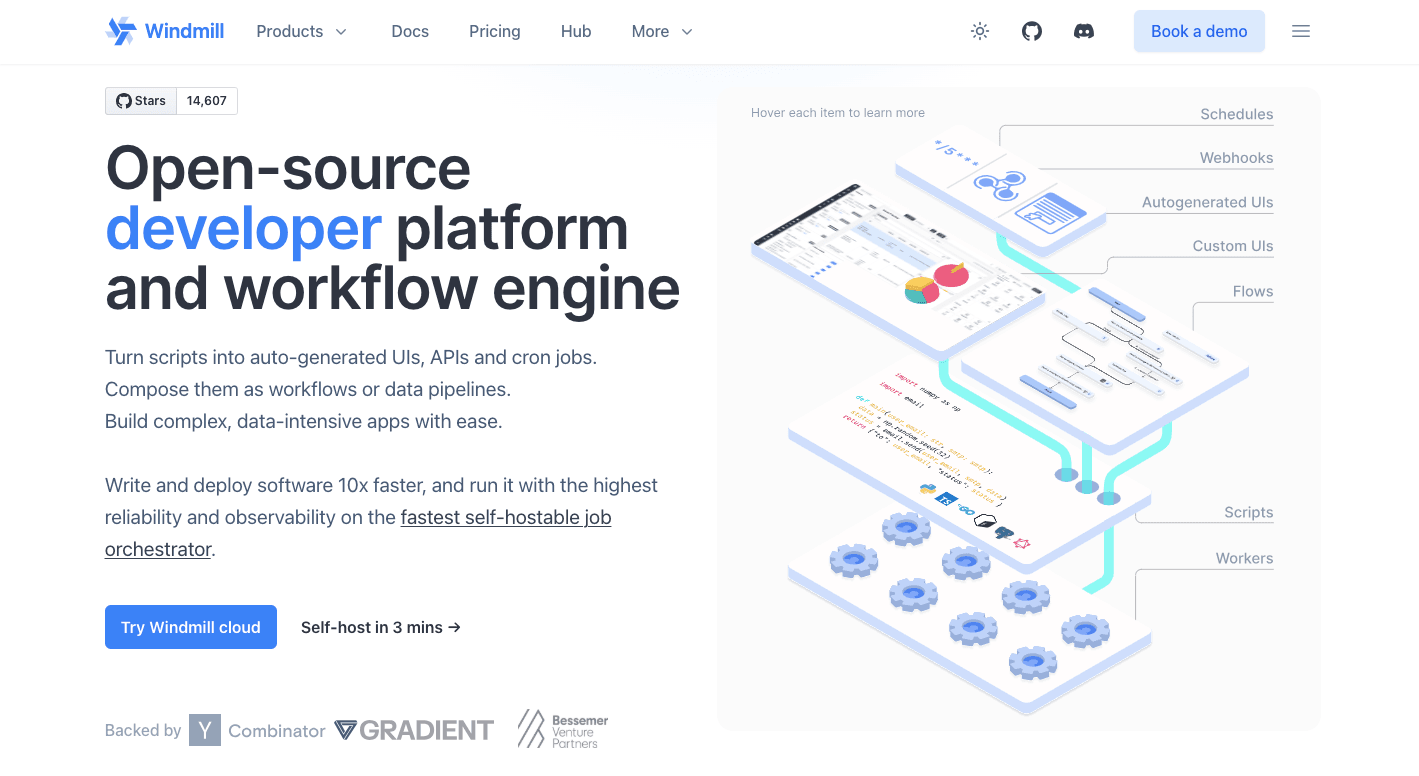
Windmill is an open-source developer platform that integrates scripting with workflow automation. Many businesses use it to build internal apps, automate jobs, and run APIs without writing endless boilerplate code.
Aside from that, it uses three main parts: scripts, flows, and apps. Your developers write scripts in their chosen language, then chain them into flows with logic for triggers, loops, and error handling.
The apps add a user interface layer too, which allows non-technical staff to run workflows created by developers. Windmill also supports webhooks, schedulers, and database events, so you can build custom solutions that integrate with your existing systems.
Features
Windmill includes a mix of developer-first and enterprise-ready tools:
- Multi-language scripts – Write in Python, TypeScript, SQL, Go, or Bash.
- No-code interface – Auto-generate simple UIs from scripts for business users.
- Flow orchestration – Drag-and-drop builder for branching, looping, and error handling.
- App builder – Create custom dashboards with reusable components.
- Dependency management – Handles packages automatically through lockfiles.
- Integrations and triggers – Launch workflows from webhooks, cron jobs, or DB events.
- Enterprise features – Fine-grained permissions, secret management, and SSO.
- AI assistance – Get help writing or debugging scripts inside the editor.
- Hosting options – Run Windmill in the cloud or self-host with Docker or Kubernetes.
Pros
- Open-source and self-hostable for full control.
- No-code interface allows operators to run scripts easily.
- Community Hub shares pre-built scripts and flows.
Cons
- Requires developer knowledge for complex builds.
- UI is less polished than pure UI-builders.
- Fewer ready-made components than some competitors.
Pricing
Windmill offers cloud-hosted and self-hosted options. The free cloud plan covers 1,000 executions monthly with no credit card required. The Team plan costs $10 per month per seat and includes 10,000 executions, while the Enterprise cloud plan costs $840 per month with unlimited audit logs.
For self-hosted setups, the platform is free and open-source with unlimited executions. Paid self-hosted tiers start at $48 per month, and then the full enterprise features and dedicated assistance are up to $120 per month.
Break Free From Zapier Limits With Activepieces
Zapier might have been your first step into automation, but it has limits.
With Activepieces, you don’t need to worry about hitting restrictive task limits or getting stuck in fixed workflows. You even get over 416 pieces and more added every day. That means you’re free to connect the tools your business actually uses and build automations that grow with you.
Developers get full control with TypeScript pieces and advanced customization, while non-technical users can use a drag-and-drop builder and a simple user interface.
Self-hosting and network-gapped options further keep sensitive data in your hands, while enterprise-ready features like approvals, branding, and role-based access empower larger teams. On top of that, native pieces and AI Copilot support let you automate workflows with intelligence from the start.
When you think that Zapier holds you back, Activepieces is the upgrade that helps you automate workflows without compromise. Why settle for limits when you can run automations built for the future?
Join for free and build smarter workflows in minutes with Activepieces!
FAQs About Zapier Alternatives
Is there automation software better than Zapier?
Yes, several automation software platforms are better than Zapier for different needs, especially for enterprises that prioritize customer engagement and customer success.
What is the Google marketing automation tool equivalent of Zapier?
The Google marketing automation tool equivalent of Zapier is Google Apps Script, although many marketers pair it with Google Workspace to connect workflows.
Why is Zapier so expensive?
Zapier is expensive because its pricing depends on task volume, and advanced features like multi-step workflows, filters, and premium integrations are locked behind higher-tier plans.
Is there a Microsoft equivalent to Zapier?
The Microsoft equivalent to Zapier is Microsoft Power Automate, which connects apps and services within the Microsoft ecosystem and beyond.


